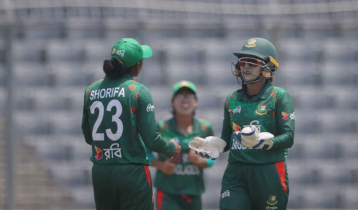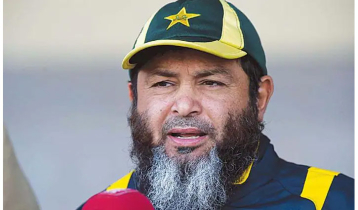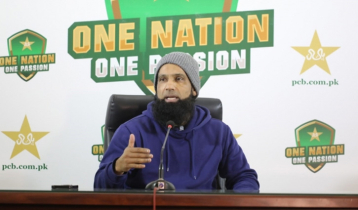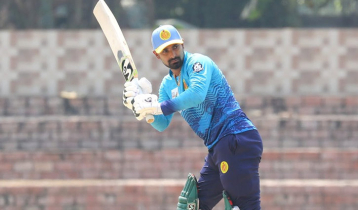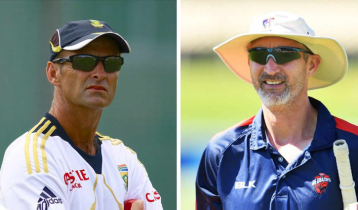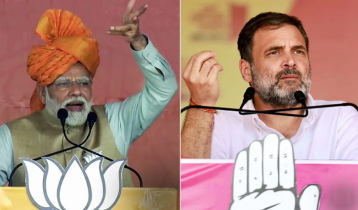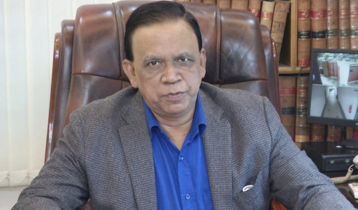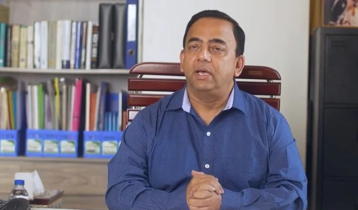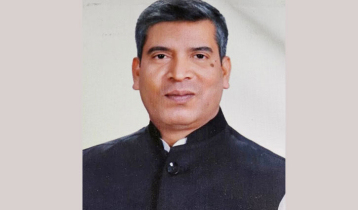CRICKET – OBSERVATION AND ANALYSIS
Monty Siddique || risingbd.com
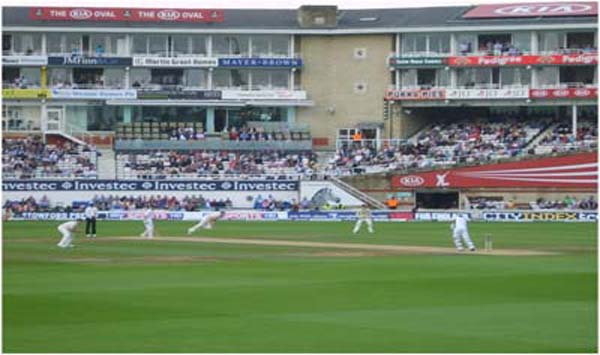
A scene from a 2013 Test Match for the Ashes between England and Australia at the Oval – by courtesy of Nooreen & Saquib.
Monty Siddique from London: We have come a long way from the era of English cricketer W. G. Grace (1848 – 1915), who is regarded to be one of the pioneers in the development of the game. According to historical accounts, the first test match was played between England and Australia as long ago as 1877. Cricket evolved into five-day test matches.
Without a shadow of a doubt, England is the cradle of cricket. The first-class County Championship is held in the summer. Then there are the Minor Counties Championship and League matches. So, logically, it follows that it would not defy belief if England presented three or four teams of world-class standard, concurrently, on the international stage.
My initiation into cricket began when, as a very young kid, I was presented with a book on cricket by my father. Other than addiction to American comic books, my interest in cricket was profound and I had completely immersed myself in learning about the cricketing legends and such field positions as slips, silly mid-on, long leg etc. I was fortunate enough to play for my school cricket team and later for my Office cricket team and, humbly, furnish my thoughts in this subject matter.
Many – unfamiliar with the game – have little patience in being engrossed for hours in following the drama as it unfolds on the cricket field. Unlike football, hockey, badminton, table tennis or any other similar sport, in which the captivated audience may be on the edges of their seats for an hour and a half; for spectators of test cricket it is analogous to being in a five-day-long endurance test. Indeed, today, empty seats abound at stadiums, in five-day test matches – indicative of a dying interest even for the diehard cricket fans.
Five-day test matches, nevertheless, have a character and an enthusiasm which are unique to the game. The players are expected to demonstrate unremitting concentration and forbearance for longer periods of time and skills that are executed with textbook precision.
Those who grew up with the game, have a taste for even a lunging forward-defensive stroke with a dead defensive bat. It demonstrates the batsman’s capability of reading the flight of the ball and the spin from the bowler’s action, whereby to assume a posture to smother the spin.
Equally thrilling to watch is the textbook cover drive, where the batsman goes through the sequence of a high backlift, a drive and a follow-through, with bat and pad close together. The driven ball is seen rolling all along the ground to the cover boundary.
A leg glance is where the ball’s trajectory, as it pitches in front of the batsman, generally follows the leg stump, and the batsman, moving forward, flicks the ball to guide it down the leg side.
A sweep shot is where the batsman kneels down on one knee and steers the ball towards square or fine leg or even to the off-side field in the case of a reverse sweep.
Looking back in history, One Day Internationals (ODIs) came into full swing in the 1970s, with the first World Cup staged in England in 1975. Then in the late 1970s Kerry Packer’s colourful extravaganza of offering lucrative contracts to leading and ambitious cricketers of several countries for limited-over cricket brought a new dimension to the game, much to the annoyance of the International Cricket Board.
ODIs have naturally raised the tempo of the game insofar as each side has to score as many runs as possible from the limited number of overs allotted to them. There are strategies and tactics which are peculiar to this type of cricket, as a consequence of rules and regulations introduced over the years.
Each bowler is restricted to bowling a maximum of ten overs, which is reduced if the match is affected by rain so as to bring down the total number of overs to below 50 (the Twenty20 International is yet another form of the game). There are also field placement restrictions.
All the restrictions notwithstanding, it is, essentially, how each side performs on the day that determines the outcome of the match. I would opine that, to a large extent, performance hinges heavily on confidence.
In general, the side that wins the toss is more likely to elect to bat first, in the hope of piling up a big total. If this is achieved, it exerts a tremendous amount of mental pressure on the team batting second. The stress becomes unbearable if the fielding side strikes a blow by capturing a few early wickets. The middle-order batsmen and the tail-enders may provide a gutsy resistance momentarily but the batting collapse may continue. This is exactly what we have witnessed in the Bangladesh-Sri Lanka match in the 2015 World Cup. Sadly, Bangladesh encountered a similar fate in the quarterfinal match with India, though Bangladesh had misgivings about umpiring decisions.
In ODIs, it is absolutely crucial for the fielding side to ensure that the bowling is of good line and length and the fielding is tight. Anything short of a length or overpitched or a half-volley is likely to be despatched to the boundary.
Because the chase for the runs is set in motion from the outset, the fielders need to be, as it were, constantly on their toes. Moreover, in the frantic pursuit of runs towards the later stages there is a plethora of unorthodox shots. Such an environment is prone to generating chances or half-chances which need to be transformed into catches. I recall one occasion some years ago when the South African, Jonty Rhodes, jumped vertically (maybe a couple of feet) upwards to block the flight of a hard-hit ball by stretching his arm – only to catch it in his subsequent body movement – to dismiss Robert Croft (England & Wales).
Going back to the match against Scotland, I was absolutely mesmerised by the variety of strokes which came off the bat of left-handed Tamim Iqbal. Many were textbook cover drives and hooks to the mid wicket or square leg regions. They were reminiscent of cover drives, square-cuts, hooks and pulls which used to be exhibited by England’s stylish left-handed batsman David Gower in the 1980s. Mind you, the English player also faced bowling of genuine pace. Some of David Gower’s shots appeared effortless and perfectly timed.
The performances of Mushfiqur Rahim, Mahmudullah and Soumya Sarkar have been quite impressive. Mushfiq has been consistently contributing good scores. Mahmudullah is a dashing right-handed batsman and a prolific scorer. Saqib-al-Hasan is an accomplished all-rounder, anyway, and needs to maintain a good line and length for his deliveries. He should aim to pitch a good-length ball between the middle and off stumps, whereby finding the outer edge of the bat of a right-hander.
A superlative all-rounder can be a match winner. Saqib is very likely to have his eyes set on reaching the standard of such iconic cricketers as Sir Ian Botham of England, Imran Khan of Pakistan, Kapil Dev of India, Jacques Kallis of South Africa and Sir Richard Hadlee of New Zealand – to name a few.
What, also, reinforces a team is the presence of a gritty middle-order batsman who can play an anchor role. In the event of a batting collapse, he can hang on as long as is necessary to continually guide and coach batsmen at the other end to plod along.
The really testing time for batsmen was perhaps the mid to late 1970s and the 1980s epoch, when a string of fearsome genuine fast bowlers were making dangerous living for batsmen. There was the dynamic duo from Australia, namely Jeff (Typhoon) Thomson and Dennis Lillee. From the West Indies sprang the fast-bowling quartet of Andy Roberts, Michael Holding, Colin Croft and Joel Garner. This was followed by the speedsters Malcolm Marshall, Courtney Walsh and Curtly Ambrose. England generated Bob Willis, Graham Dilley and Devon Malcolm (more into the 1990s) amongst others. Pakistan produced Imran Khan who, later, teamed up with Wasim Akram and Waqar Younis – all reverse-swing specialists.
Many Australian cricketers regard Thomson to be the fastest bowler of all time, though the mantle is claimed by Rawalpindi Express Shoaib Akhtar, who was clocked with deliveries at over 100 miles per hour.
Top-order batsmen, after having survived the ferocious West Indian ("Windies’") opening spell of authentic fast bowling, still had no respite as they then had to sustain another nerve-wracking session with a further stock of West Indian fast bowlers. In such situations, one would, invariably, witness four slips and a gully as an attacking field placement. This constant psychological pressure on their opponents was what kept the Windies on top for a long time.
Of course, to add to the armoury, the Windies showcased the brilliance of Vivian Richards, Gordon Greenidge, Desmond Haynes, Brian Lara etc. – undisputed leading world-class batsmen. Any cricketing nations would be only too proud to have batsmen of such calibre, as they would with such gifted performers as Sunil Gavaskar and Sachin Tendulkar of India, Allan Border and Ricky Ponting of Australia, Javed Miandad and Inzamam-ul-Haq of Pakistan, Graham Gooch and Alastair Cook of England, AB De Villiers and Hashim Amla of South Africa, Kumar Sangakkara and Mahela Jayawardene of Sri Lanka, etc. There are numerous other names, worthy of mention but, perhaps, on another occasion.
Mashrafe Bin Mortaza (Narail Express), Taskin Ahmed, Rubel Hossain and Shahadat Hossain have the height and physique to elevate their bowling speed in becoming Bangladesh’s fast-bowling war machine for years to come. Perhaps they could study videos on the length of running up to the wicket and the style of delivery of fast bowlers of the 1980s and 1990s. Some fast bowlers required a relatively short run up to the wicket.
If they cannot increase their speed of delivery, they can, at least, endeavour to produce in-swinging yorkers, out-swingers and reverse swing more often. It is more productive to deceive batsmen with swing bowling than to unleash a battery of fast, but erratic, bowling.
An overwhelming majority of batsmen are right-handed. And it is no secret that right-handed batsmen can often struggle to read the spin of a right-arm leg spinner. This is particularly so if the ball pitches on the blind spot or is a googly, a top spinner or a flipper. With this in mind, Bangladesh should strive to develop and experiment with leg-spin bowling. Australia’s Shane Warne was master of the art of leg-spin bowling, as was the “magician” Abdul Qadir.
Bangladesh is a single-province state and has limited sporting resources. They have been referred to as minnows of cricket. Yet, against all odds, Bangladesh cricketers have projected themselves on the international arena, through sheer drive and determination, as a cricket team to reckon with. It is a credit to Bangladesh cricketers.
Bangladesh cricketers displayed a competitive mindset in the 2015 World Cup. The momentum seems to have carried them over to score a landslide victory over Pakistan in the current ODI series and in the sole T20 match.
A test match is a different proposition altogether. Nevertheless, the Bangladesh cricket team are expected to face the challenge boldly and with ingenuity in the current short test series.
Finally, I conclude this piece with a tribute to the eminent cricket commentator and cricketer, Richie Benaud, who passed away recently. The beaming of this illustrious Australian’s image on the TV screen was a pleasant reminder that we were in for an entertaining session of cricket. He would not only submit his valuable analysis of episodes of the match, but also enlighten us with historical narratives.
This article is written by Monty Siddique BSc (Hons) in Industrial Chemistry from a UK University, who served in the United Kingdom Civil Service, as a Senior Patent Examiner (above Principal Level) in the United Kingdom Intellectual Property Office, which is the operating name of the United Kingdom Patent Office. He has also trained and managed UK patent examiners.
risingbd/DHAKA/May 3, 2015/Monty/Mukul
risingbd.com



